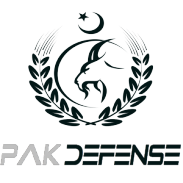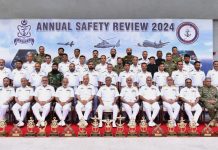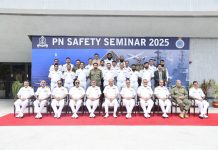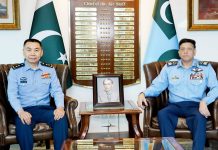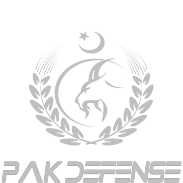Reading Time: 6 minutes approx.
Significance of Centre of Artificial Intelligence & Computing For PAKISTAN AIR FORCE:
PAKISTAN AIR FORCE has received yet another milestone by inaugurating the cutting-edge Centre of Artificial Intelligence & Computing (CENTAIC) at Air Headquarters (AHQ) Islamabad.
PAKISTAN AIR FORCE CHIEF Air Marshal Mujahid Anwar Khan inaugurated the CENTAIC and graced the occasion as the Chief Guest.
The main purpose of establishing the center is to boost the Air Warfare Capabilities and Applications of PAKISTAN AIR FORCE for its current and upcoming projects.
The CENTAIC will act as the fusion center for PAF for research in a number of fields, including the machine learning, Natural Language Processing (NLP), predictive learning and deep learning.
سربراہ پاک فضائیہ ائیر چیف مارشل مجاہد انور خان نے آج اسلام آباد میں سینٹرآف آرٹیفیشل انٹیلیجنس اینڈ کمپیوٹنگ کا افتتاح کیا۔
سینٹر کا مقصد آرٹیفیشل انٹیلیجنس ریسرچ کو سول اور ملٹری شعبہ جات میں فروغ دینا ہے۔ https://t.co/y6qDAaSZ39 pic.twitter.com/Wr9XYC5TJL
— DGPR (AIR FORCE) (@DGPR_PAF) August 27, 2020
The facility can also be used for developing complex algorithms for the weapon system of PAKISTAN’s Fifth Generation Fighter Jet, including the air to surface and air surface missiles, sensor fusions, Human Machine Interface (HMI), TV/IR Seekers and other applications.
The Centre of Artificial Intelligence & Computing (CENTAIC) would also be used for the research of AESA Radars and transmit and receive modules (TRM).
Significance of Centre of Artificial Intelligence & Computing (CENTAIC) For PAF:
-
Natural Language Processing (NLP):
The Natural Language Processing or NLP enables computers interact, coordinate and communicate with people. The NLP is a quite newer term in the aviation industry, but there is a huge significance and demand of NLP today.

For instance, a single stealth aircraft could easily record and generate a vast amount of data from variety of sensors.
In the instance, if an enemy Fifth Generation Fighter Aircraft tried to evade radar, the Fifth Generation Fighter Aircraft could alert the pilot with a specific code, light or screen.
As the pilot has only limited time to engage with several aerial objects simultaneously, so the effectiveness of NLP comes into force as it can easily minimize the risk of overloaded information to the pilot.
-
Predictive Analysis:
The predictive analysis is basically the type of analysis to predict what is most likely to occur in the next phase. The Predictive Analysis can also be used for the future troubleshooting and maintenance of aircraft maintained by PAKISTAN AIR FORCE.

With the help of this system, PAF can easily maintain its inventory, including its sensor and weapons systems, to set-up predictive and preventive maintenance schedules.
In the long term, the Predictive Analysis can significantly reduce the down-time and repair costs of the fighter aircraft maintained by PAKISTAN AIR FORCE, including PAKISTAN’s Pride JF-17 Thunder.
-
Big Data:
Big Data is basically the process of identifying correlation, insights and trends from different sources of information. The basic purpose of using the Big Data is to improve the decision-making ability.

As far as PAF is concerned, PAKISTAN AIR FORCE can easily draw data from a number of sources, including the Damage Tolerance Analysis/Structural Health Management (DTA/SHM) tools used at PAC Kama and instrumentation equipment at the Sonmiani Weapons Testing Range (WTR).
Additionally, the CENTAIC and Big Data system will enable the PAKISTAN AIR FORCE to extract 1000 hours of flight data from desired aircraft.
The Big Data System will help the PAKISTAN AIR FORCE to cut maintenance downtime, lower maintenance cost and to increase the efficiency of a fighter jet.
-
Machine Learning:
Machine Learning is a type of Artificial Data that tries to learn from the past results and data in order to make better decisions in future. The Machine Learning significantly helps the planner to execute and informed decision and to use the algorithm to understand the type of data extracted from various sources.

The Machine Learning can easily examine heavy data across terabytes or even petabytes in a quick and efficient manner.
Some examples of Machine Learning are adaptive flight control system, online emergency flight plan generation, electronic warfare, online optimal guidance for munitions and flight model learning from flight data.
-
Deep Learning:
Deep Learning is basically the sub-field of Machine Learning. The DL runs through different layers of different programs to pull conclusions from various sources.

As the Machine Learning use various algorithms to examine data, deep learning uses algorithms into ‘Artificial Neural Networks’ that could make autonomous decisions.
The Deep Learning can work best for UAV’s and Armed Drones that flies and work with minimum or limited human control or input.
PAKISTAN AIR FORCE (PAF) may use this technology into its next generation Medium Altitude Long Endurance (MALE) Unmanned Aerial Vehicle (UAVs), which is still in the pipeline.
